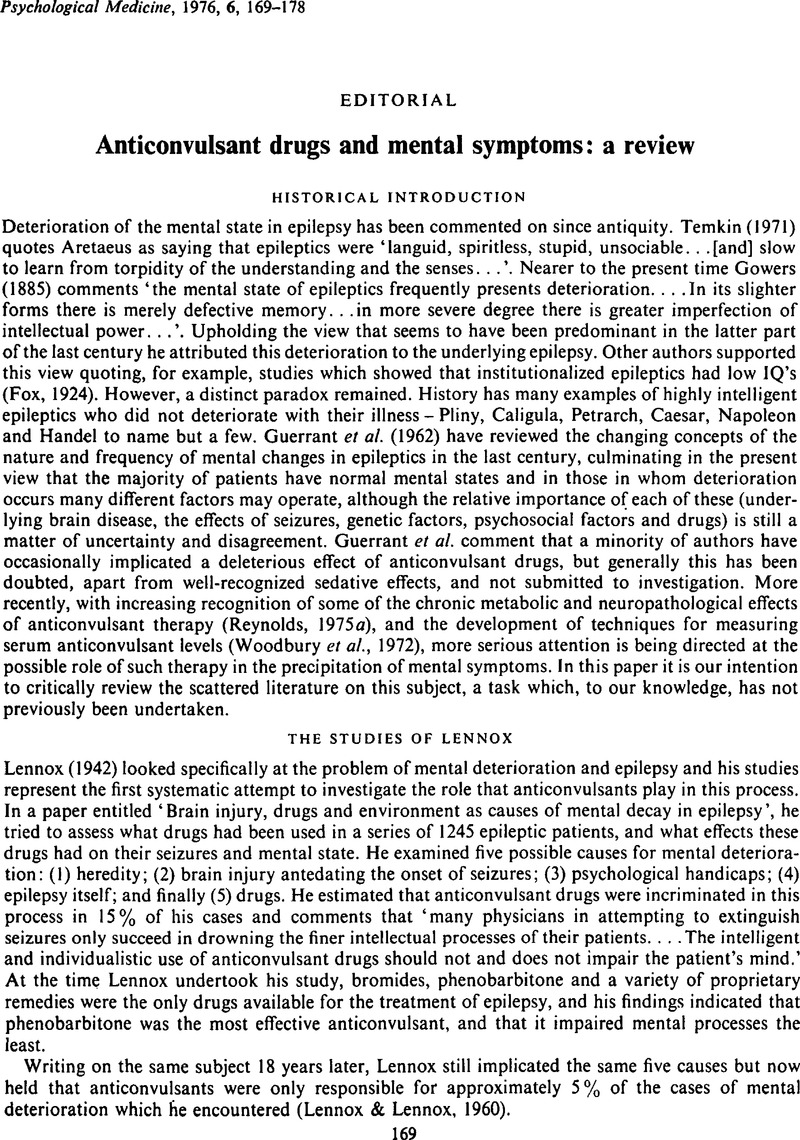Crossref Citations
This article has been cited by the following publications. This list is generated based on data provided by Crossref.
Blanchet-Cohen, Therèse
and
Cohen, NicholasM
1976.
HELPING THE NOMADS.
The Lancet,
Vol. 308,
Issue. 7977,
p.
149.
Gunn, John
Reynolds, E.H.
Chadwick, D.
and
Galbraith, A.W.
1976.
ONE DRUG (PHENYTOIN) IN TREATMENT OF EPILEPSY.
The Lancet,
Vol. 308,
Issue. 7977,
p.
150.
Reynolds, E.H.
1976.
Neurological Aspects of Folate and Vitamin B12 Metabolism.
Clinics in Haematology,
Vol. 5,
Issue. 3,
p.
661.
Werry, John S.
1977.
The Use of Psychotropic Drugs in Children.
Journal of the American Academy of Child Psychiatry,
Vol. 16,
Issue. 3,
p.
446.
Scott, D. F.
1978.
Psychiatric Aspects of Epilepsy.
British Journal of Psychiatry,
Vol. 132,
Issue. 5,
p.
417.
Carney, M. W. P.
and
Sheffield, B. F.
1978.
Serum folic acid and B12 in 272 psychiatric in-patients.
Psychological Medicine,
Vol. 8,
Issue. 1,
p.
139.
Reynolds, E.H.
1978.
DRUG TREATMENT OF EPILEPSY.
The Lancet,
Vol. 312,
Issue. 8092,
p.
721.
Shaywitz, Bennett A.
and
Pearson, David A.
1978.
Effects of phenobarbital on activity and learning in 6-hydroxydopamine treated rat pups.
Pharmacology Biochemistry and Behavior,
Vol. 9,
Issue. 2,
p.
173.
Neugebauer, Richard
and
Susser, Mervyn
1979.
Epilepsy: some epidemiological aspects.
Psychological Medicine,
Vol. 9,
Issue. 2,
p.
207.
Bittencourt, P R
Gresty, M A
and
Richens, A
1980.
Quantitative assessment of smooth-pursuit eye movements in healthy and epileptic subjects..
Journal of Neurology, Neurosurgery & Psychiatry,
Vol. 43,
Issue. 12,
p.
1119.
LOBASCHER, M. E.
and
CAVANAGH, N. P. C.
1980.
PATTERNS OF INTELLECTUAL CHANGE IN THE DEMENTING SCHOOL CHILD.
Child: Care, Health and Development,
Vol. 6,
Issue. 5,
p.
255.
1980.
Mechanisms of chemical carcinogenesis..
BMJ,
Vol. 281,
Issue. 6239,
p.
529.
Reynolds, E.H.
1980.
Ciba Foundation Symposium 74 ‐ Drug Concentrations in Neuropsychiatry.
Vol. 74,
Issue. ,
p.
199.
Reynolds, E.H.
1980.
Serum levels of anticonvulsant drugs interpretation and clinical value.
Pharmacology & Therapeutics,
Vol. 8,
Issue. 2,
p.
217.
1980.
Suicide and epilepsy..
BMJ,
Vol. 281,
Issue. 6239,
p.
530.
Sonis, William A.
Petti, Theodore A.
and
Rickey, Eldred T.
1981.
Epilepsy and Psychopathology in Childhood: A Controlled Study with Carbamazepine.
Journal of the American Academy of Child Psychiatry,
Vol. 20,
Issue. 2,
p.
398.
Whitlock, F. A.
1981.
Adverse Psychiatric Reactions to Modern Medication.
Australian & New Zealand Journal of Psychiatry,
Vol. 15,
Issue. 2,
p.
87.
Libiger, Jan
and
Ban, Thomas A
1981.
Drug induced dementia.
Progress in Neuro-Psychopharmacology,
Vol. 4,
Issue. 6,
p.
561.
Werry, Johns.
1981.
Drugs AND Learning.
Journal of Child Psychology and Psychiatry,
Vol. 22,
Issue. 3,
p.
283.
WERRY, JOHN S.
1982.
Advances in Pediatric Psychopharmacology Part I: Introduction.
Journal of the American Academy of Child Psychiatry,
Vol. 21,
Issue. 1,
p.
1.



